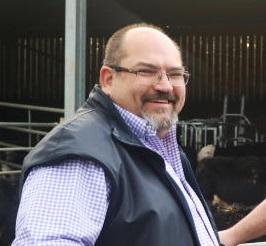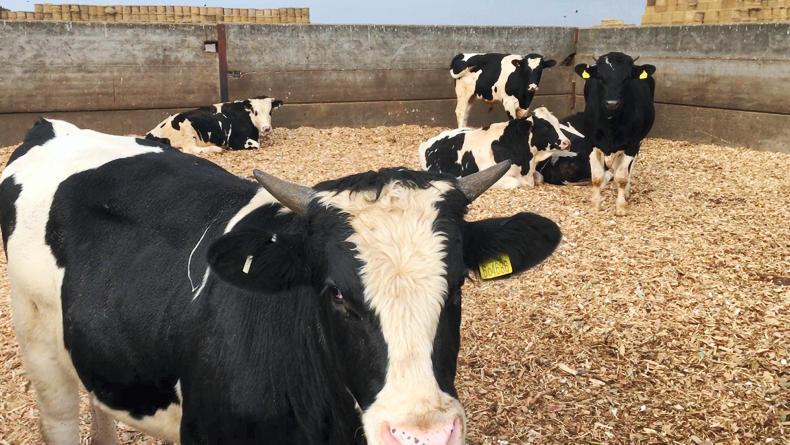A thriving calf is a healthy calf – animal health is the foundation of any successful calf-rearing enterprise. But even if we tick every box on the optimum health checklist, chances are that, at some point during the rearing phase, sickness will strike.
Here, the rearer’s own diagnostic skills come into play. An astute rearer will easily identify a poorly calf based on visual signs. But, at this point, an antibiotic is the likely remedy. In a society where antimicrobial resistance is a growing concern, is there scope to nip illness in the bud before it reaches this point?
Heating up
An animal’s body temperature can rise for a number of reasons, one of which being an inflammatory response to infection (fever). This is a defence mechanism, whereby a gland in the animal’s brain (hypothalamus) detects disease-causing agents in the system and essentially tries to burn them out.

This rise in temperature can come up to 20 hours before an obvious visual sign of infection, such as nasal discharge, and as much as 65 hours before coughing develops.
While recent years have seen a number of remote cattle thermometers enter the market, many of which had weakness in their design and efficacy, a company in Amarillo, Texas, has developed what seems a fit-for-purpose device.
How it works
The FeverTag TempVerified device is matchbox-sized with a 5in wire probe for measuring temperature. It is fastened to the animal’s ear using a conventional tagger, with the probe then fed into the ear canal.
Here, it is in close proximity to the hypothalamus (brain gland controlling body temperature). The device takes a temperature reading every 15 minutes and an ultra-bright LED light alarm flashes if the animal’s temperature remains heightened (>39.7°C) for six hours. In case of an alarm, the company advises a rectal temperature to confirm fever. The tags have a two-year continuous battery life.
Put to the test
In a German study carried out by MSD (coincidentally a FeverTag distributer) involving two rearing farms, 80 rectal-confirmed cases of FeverTag alarm were treated with either a combination of an anti-inflammatory (flunixin) and antibiotic (florfenicol) (37) or solely an anti-inflammatory (43).
Besides a slight discharge from the eyes in a few calves, no other clinical signs were visible. Appetite was not reduced in all but two calves. In 67% of the anti-inflammatory-only calves, no further treatment (antibiotic) was necessary.
In a similar trial at the Royal Veterinary College, antibiotic requirement was reduced by over 30% where FeverTags were used to identify heightened body temperature in rearing calves.
Working on the ground
 Rob Drysdale (pictured) runs an integrated dairy calf-to-beef system in southern England, which involves calves from 40 local dairy farms initially moving to one of two calf-rearing enterprises.
Rob Drysdale (pictured) runs an integrated dairy calf-to-beef system in southern England, which involves calves from 40 local dairy farms initially moving to one of two calf-rearing enterprises.
All are fitted with FeverTags on arrival. A qualified vet, Rob understands the importance of early and proper diagnosis. Rob and I visited one of his calf-rearing farms, run by Alex Baker in West Sussex.
“My system is integrated and involves five parties: the buyer, the rearer, the grower, the finisher and myself. That’s five people looking to make a return on each and every animal.
“For this to happen, the animal mustn’t experience a growth check at any point in the system. Any potential check is most likely to come via respiratory illness during the rearing phase – that’s where the FeverTags come in.
“They’re £15 each, but they have reduced our usage of potent antibiotics like Draxxin by 100% and other treatments by 33%. Our calf rearers have switched to weaker antibiotics and often get by on anti-inflammatories alone.
“The tags also eliminate the need for the segregation of sick animals in many cases. I have seen 0% mortality in 500 calves and have had only 1% that were out of spec for our integration project.”
Read more
Focus: calves 2017
A thriving calf is a healthy calf – animal health is the foundation of any successful calf-rearing enterprise. But even if we tick every box on the optimum health checklist, chances are that, at some point during the rearing phase, sickness will strike.
Here, the rearer’s own diagnostic skills come into play. An astute rearer will easily identify a poorly calf based on visual signs. But, at this point, an antibiotic is the likely remedy. In a society where antimicrobial resistance is a growing concern, is there scope to nip illness in the bud before it reaches this point?
Heating up
An animal’s body temperature can rise for a number of reasons, one of which being an inflammatory response to infection (fever). This is a defence mechanism, whereby a gland in the animal’s brain (hypothalamus) detects disease-causing agents in the system and essentially tries to burn them out.

This rise in temperature can come up to 20 hours before an obvious visual sign of infection, such as nasal discharge, and as much as 65 hours before coughing develops.
While recent years have seen a number of remote cattle thermometers enter the market, many of which had weakness in their design and efficacy, a company in Amarillo, Texas, has developed what seems a fit-for-purpose device.
How it works
The FeverTag TempVerified device is matchbox-sized with a 5in wire probe for measuring temperature. It is fastened to the animal’s ear using a conventional tagger, with the probe then fed into the ear canal.
Here, it is in close proximity to the hypothalamus (brain gland controlling body temperature). The device takes a temperature reading every 15 minutes and an ultra-bright LED light alarm flashes if the animal’s temperature remains heightened (>39.7°C) for six hours. In case of an alarm, the company advises a rectal temperature to confirm fever. The tags have a two-year continuous battery life.
Put to the test
In a German study carried out by MSD (coincidentally a FeverTag distributer) involving two rearing farms, 80 rectal-confirmed cases of FeverTag alarm were treated with either a combination of an anti-inflammatory (flunixin) and antibiotic (florfenicol) (37) or solely an anti-inflammatory (43).
Besides a slight discharge from the eyes in a few calves, no other clinical signs were visible. Appetite was not reduced in all but two calves. In 67% of the anti-inflammatory-only calves, no further treatment (antibiotic) was necessary.
In a similar trial at the Royal Veterinary College, antibiotic requirement was reduced by over 30% where FeverTags were used to identify heightened body temperature in rearing calves.
Working on the ground
 Rob Drysdale (pictured) runs an integrated dairy calf-to-beef system in southern England, which involves calves from 40 local dairy farms initially moving to one of two calf-rearing enterprises.
Rob Drysdale (pictured) runs an integrated dairy calf-to-beef system in southern England, which involves calves from 40 local dairy farms initially moving to one of two calf-rearing enterprises.
All are fitted with FeverTags on arrival. A qualified vet, Rob understands the importance of early and proper diagnosis. Rob and I visited one of his calf-rearing farms, run by Alex Baker in West Sussex.
“My system is integrated and involves five parties: the buyer, the rearer, the grower, the finisher and myself. That’s five people looking to make a return on each and every animal.
“For this to happen, the animal mustn’t experience a growth check at any point in the system. Any potential check is most likely to come via respiratory illness during the rearing phase – that’s where the FeverTags come in.
“They’re £15 each, but they have reduced our usage of potent antibiotics like Draxxin by 100% and other treatments by 33%. Our calf rearers have switched to weaker antibiotics and often get by on anti-inflammatories alone.
“The tags also eliminate the need for the segregation of sick animals in many cases. I have seen 0% mortality in 500 calves and have had only 1% that were out of spec for our integration project.”
Read more
Focus: calves 2017

 Rob Drysdale (pictured) runs an integrated dairy calf-to-beef system in southern England, which involves calves from 40 local dairy farms initially moving to one of two calf-rearing enterprises.
Rob Drysdale (pictured) runs an integrated dairy calf-to-beef system in southern England, which involves calves from 40 local dairy farms initially moving to one of two calf-rearing enterprises. 













SHARING OPTIONS